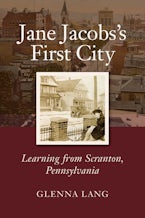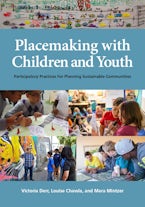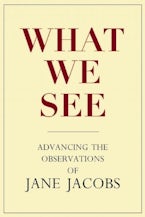New Village Press publishes innovative, interrogative titles in Urban Studies, and below, we’ve rounded up a sampling of their excellent list. If you are interested in requesting a desk / exam copy of one or more titles, please click on the purple button below the cover of the book you want to fill out a request form. Please note that you must fill out a form for each title you wish to receive. If you are an international scholar, please review our policy here.
How a City's Heart Connects Us All
$21.95
9781613321263
New Village Press
Mindy Thompson Fullilove traverses the central thoroughfares of our cities to uncover the ways they bring together our communities
After an 11-year study of Main Streets in 178 cities and 14 countries, Fullilove discovered the power of city centers to “help us name and solve our problems.” In an era of compounding crises including racial injustice, climate change, and COVID-19, the ability to rely on the power of community is more important than ever. However, Fullilove describes how a pattern of disinvestment in inner-city neighborhoods has left Main Streets across the U.S. in disrepair, weakening our cities and leaving us vulnerable to catastrophe.
In the face of urban renewal programs built in response to a supposed lack of “personal responsibility,” Fullilove offers “a different story, that of a series of forced displacements that had devastating effects on inner-city communities. Through that lens, we can appreciate the strength of segregated communities that managed to temper the ravages of racism through the Jim Crow era, and build political power and many kinds of wealth. . . . Only a very well-integrated, powerful community—one with deep spiritual principles—could have accomplished such a feat.” This is the power she hopes we will find again.
Throughout Main Street, readers glimpse strong, vibrant communities who have conquered a variety of disasters, from the near loss of a beloved local business to the devastation of a hurricane. Using case studies to illustrate her findings, Fullilove turns our eyes to the cracks in city centers, the parts of the city that tend to be avoided or ignored. Providing a framework for those who wish to see their communities revitalized, Fullilove’s Main Street encourages us all to look both inward and outward to find the assets that already exist to create meaningful change.
Place Makers Tell Their Stories
$30.00
9781613321423
New Village Press
Useful and inspiring cases illustrate participatory placemaking practices and strategies.
How Spaces Become Places tells stories of place makers who respond to daunting challenges of affordable housing, racial violence, and immigration, as well as community building, arts development, safe streets, and coalition-building. The book's thirteen contributors share their personal experiences tackling complex and contentious situations in cities ranging from Brooklyn to Los Angeles and from Paris to Detroit. These activists and architects, artists and planners, mediators and gardeners transform ordinary spaces into extraordinary places.
These place makers recount working alongside initially suspicious residents to reclaim and enrich the communities in which they live. Readers will learn how place makers listen and learn, diagnose local problems, convene stakeholders, build trust, and invent solutions together. They will find instructive examples of work they can do within their own communities. In the aftermath of the pandemic and the murder of George Floyd, the editor argues, these accessible practice stories are more important than ever.
Learning from Scranton, Pennsylvania
$39.95
9781613321393
New Village Press
A thorough investigation of how Jane Jacobs’s ideas about the life and economy of great cities grew from her home city, Scranton
Jane Jacobs’s First City vividly reveals how this influential thinker and writer’s classic works germinated in the once vibrant, mid-size city of Scranton, Pennsylvania, where Jane spent her initial eighteen years. In the 1920s and 1930s, Scranton was a place of enormous diversity and opportunity. Small businesses of all kinds abounded and flourished, quality public education was available to and supported by all, and even recent immigrants could save enough to buy a house. Opposing political parties joined forces to tackle problems, and citizens worked together for the public good.
Through interviews with contemporary Scrantonians and research of historic newspapers, city directories, and vital records, author Glenna Lang has uncovered Scranton as young Jane experienced it and shows us the lasting impact of her growing up in this thriving and accessible environment. Readers can follow the development of Jane’s acute observational abilities from childhood through her passion in early adulthood to understand and write about what she saw. Reflecting Jane’s belief in trusting one’s own direct observation above all, this volume has been richly illustrated with historic and modern color images that help bring alive a lost Scranton. The book demonstrates why, at the end of Jacobs’s life, her thoughts and conversations increasingly returned to Scranton and the potential for cohesion and inclusiveness in all cities.
Placemaking with Children and Youth
Participatory Practices for Planning Sustainable Communities
$40.00
9781613321003
New Village Press
An illustrated, essential guide to engaging children and youth in the process of urban design
From a history of children’s rights to case studies discussing international initiatives that aim to create child-friendly cities, Placemaking with Children and Youth offers comprehensive guidance in how to engage children and youth in the planning and design of local environments. It explains the importance of children’s active participation in their societies and presents ways to bring all generations together to plan cities with a high quality of life for people of all ages. Not only does it delineate best practices in establishing programs and partnerships, it also provides principles for working ethically with children, youth, and families, paying particular attention to the inclusion of marginalized populations.
Drawing on case studies from around the world—in Australia, New Zealand, Canada, India, Puerto Rico, the Netherlands, South Africa, and the United States—Placemaking with Children and Youth showcases children’s global participation in community design and illustrates how a variety of methods can be combined in initiatives to achieve meaningful change. The book features more than 200 visuals and detailed, thoughtful guidelines for facilitating a multiplicity of participatory processes that include drawing, photography, interviews, surveys, discussion groups, role playing, mapping, murals, model making, city tours, and much more. Whether seeking information on individual methods and project planning, interpreting and analyzing results, or establishing and evaluating a sustained program, readers can find practical ideas and inspiration from six continents to connect learning to the realities of students’ lives and to create better cities for all ages.
A Story of People's Power
$20.00
9781613320327
New Village Press
The story of a union organizer who found a second career in community organizing and helped a Jim Crow city become a better place.
Ernest Thompson dedicated his life to organizing the powerless. This lively, illustrated personal narrative of his work shows the great contribution that people’s coalitions can make to the struggle for equality and freedom. Thompson cut his teeth organizing one of the great industrial unions, the United Electrical Radio and Machine Workers of America, and brought his organizing skills and commitment to coalition building to Orange, New Jersey. He built a strong organization and skillfully led fights for school desegregation, black political representation, and strong government in a city he initially thought of as a “dirty Jim Crow town going nowhere.” Thompson came to love the City of Orange and its caring citizens, seeing in its struggles a microcosm of America. This story of people’s power is meant for all who struggle for human rights, economic opportunity, decent housing, effective education, and a chance for children to have a better life.
Ernest Thompson (1906-1971) grew up on the Eastern Shore of Maryland, on a farm that had been given to his family at the end of the Civil War. The family was very poor and oppressed by racist practices. Thompson was determined to get away and to obtain power. He migrated to Jersey City, where he became part of the union organizing movement that built the Congress of Industrial Unions (CIO). He became the first African American to hold a fulltime organizing position with his union, the United Electrical Radio and Machine Workers of America (UE). He eventually headed UE’s innovative Fair Employment Practices program and fought for equal rights and pay for women and minority workers. Thompson also helped build the National Negro Labor Council, 1951-1956, and served as its director of organizing. In 1956, under the onslaught of the McCarthy era, UE was split in two, and Thompson lost his job. His wife, Margaret Thompson, brought the local school segregation to his attention. Ernie “Home” Thompson organized to desegregate the regional schools, building strong coalitions and political power for the black community that ultimately served all the people of Orange.
How Tearing Up City Neighborhoods Hurts America, And What We Can Do About It
$22.95
9781613320198
New Village Press
Root Shock examines 3 different U.S. cities to unmask the crippling results of decades-old disinvestment in communities of color and the urban renewal practices that ultimately destroyed these neighborhoods for the advantage of developers and the elite.
Like a sequel to the prescient warnings of urbanist Jane Jacobs, Dr. Mindy Thompson Fullilove reveals the disturbing effects of decades of insensitive urban renewal projects on communities of color. For those whose homes and neighborhoods were bulldozed, the urban modernization projects that swept America starting in 1949 were nothing short of an assault. Vibrant city blocks - places rich in culture - were torn apart by freeways and other invasive development, devastating the lives of poor residents. Fullilove passionately describes the profound traumatic stress- the "root shock"that results when a neighborhood is demolished. She estimates that federal and state urban renewal programs, spearheaded by business and real estate interests, destroyed 1,600 African American districts in cities across the United States. But urban renewal didn't just disrupt black communities: it ruined their economic health and social cohesion, stripping displaced residents of their sense of place as well. It also left big gashes in the centers of cities that are only now slowly being repaired. Focusing on the Hill District of Pittsburgh, the Central Ward in Newark, and the small Virginia city of Roanoke, Dr. Fullilove argues powerfully against policies of displacement. Understanding the damage caused by root shock is crucial to coping with its human toll and helping cities become whole. Mindy Thompson Fullilove, MD, is a research psychiatrist at New York State Psychiatric Institute and professor of clinical psychiatry and public health at Columbia University. She is the author of five books, including Urban Alchemy.
The Earth, the City, and the Hidden Narrative of Race
$21.95
9781613320211
New Village Press
In this work, Carl Anthony shares his perspectives as an African-American child in post-World War II Philadelphia; a student and civil rights activist in 1960s Harlem; a traveling student of West African architecture; and an architect, planner, and environmental justice advocate in Berkeley. He contextualizes this within American urbanism and human origins, making profoundly personal both African American and American urban histories as well as planetary origins and environmental issues, to not only bring a new worldview to people of color, but to set forth a truly inclusive vision of our shared planetary future.
The Earth, the City, and the Hidden Narrative of Race connects the logics behind slavery, community disinvestment, and environmental exploitation to address the most pressing issues of our time in a cohesive and foundational manner. Most books dealing with these topics and periods silo issues apart from one another, but this book contextualizes the connections between social movements and issues, providing tremendous insight into successful movement building. Anthony's rich narrative describes both being at the mercy of racism, urban disinvestment, and environmental injustice as well as fighting against these forces with a variety of strategies.
Because this work is both a personal memoir and an exposition of ideas, it will appeal to those who appreciate thoughtful and unique writing on issues of race, including individuals exploring their own African American identity, as well as progressive audiences of organizations and community leaders and professionals interested in democratizing power and advancing equitable policies for low-income communities and historically disenfranchised communities.
Advancing the Observations of Jane Jacobs
$26.95
9780981559315
New Village Press
A timely revisitation of renowned urbanist-activist Jane Jacobs' lifework, What We See invites thirty pundits and practitioners across fields to refresh Jacobs' economic, social and urban planning theories for the present day. Combining personal and professional observations with meditations on Jacobs' insights, essayists bring their diverse experience to bear to sketch the blueprints for the living city.
The book models itself after Jacobs' collaborative approach to city and community building, asking community members and niche specialists to share their knowledge with a broader community, to work together toward a common goal of building the 21st-century city.
The resulting collection of original essays expounds and expands Jacobs' ideas on the qualities of a vibrant, robust urban area. It offers the generalist, the activist, and the urban planner practical examples of the benefits of planning that encourages community participation, pedestrianism, diversity, environmental responsibility, and self-sufficiency.
Bob Sirman, director of the Canada Council for the Arts, describes how built form should be an embodiment of a community narrative. Daniel Kemmis, former Mayor of Missoula, shares an imagined dialog with Jacobs, discussing the delicate interconnection between cities and their surrounding rural areas. And Roberta Brandes Gratz?urban critic, author, and former head of Public Policy of the New York State Preservation League?asserts the importance of architectural preservation to environmentally sound urban planning practices.
What We See asks us all to join the conversation about next steps for shaping socially just, environmentally friendly, and economically prosperous urban communities.
Freedom of Assembly and the Occupation of Public Space
$19.95
9781613320099
New Village Press
In the wake of the Occupy Wall Street movement, leading planers and social scientists examine public space today and freedom of assembly.
The Occupy Wall Street movement has challenged the physical manifestation of the First Amendment rights to freedom of assembly. Where and how can people congregate today? Forty social scientists, planners, architects, and civil liberties experts explore the definition, use, role, and importance of public space for the exercise of our democratic rights to free expression. The book also discusses whose voice is heard and what factors limit the participation of minorities in Occupy activities. This foundational work puts issues of democracy and civic engagement back into the center of dialogue about the built environment.
Beyond Zuccotti Park is a collaborative effort of Pratt Graduate Center for Planning and the Environment, City College of New York School of Architecture, New Village Press and its parent organization, Architects/Designers/Planners for Social Responsibility. The book is part of an open civic inquiry on the part of these organizations. The project was seeded by a series of free public forums, Freedom of Assembly: Public Space Today, held at the Center for Architecture in response to the forced clearance of Occupy activities from Zuccotti Park and public plazas throughout the country. The first two recorded programs took place on December 17, 2011 and February 4, 2012.









